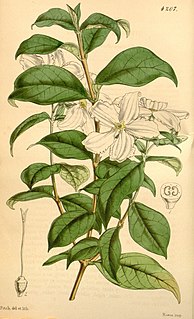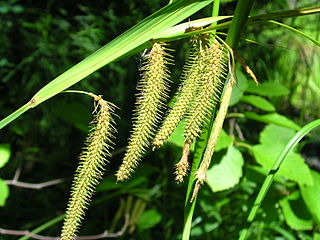Related Research Articles

Acanthophoenix rubra, the barbel palm, is a critically endangered palm endemic to Mauritius, Rodrigues, and La Reunion that is prized for its edible palm hearts.

Gentianopsis crinita is a biennial herbaceous species, native to eastern USA and eastern Canada. The flowers of fringed gentian open on sunny days, but generally remain closed on cloudy days. Individual plants live for only one or two years; the plant is noted as having become relatively rare.

Coccothrinax crinita is a palm which is endemic to Cuba. Like other members of the genus Coccothrinax, C. barbadensis is a fan palm.

Thelymitra crinita, commonly known as the blue lady orchid, the queen orchid, the lily orchid, is a species of orchid which is endemic to the south-west of Western Australia. It has a single broad, oval leaf and up to fifteen brilliant blue flowers with a blue column with the lobe on top of the anther covered with short, finger-like calli.
Austrostipa crinita is a species of grass that grows in coastal parts of midwest Western Australia.

Luzula crinita is a species of flowering plant in the rush family that is native to the subantarctic islands of New Zealand and Australia. The specific epithet comes from the Latin crinitus, with reference to the leaves.

Cryptantha crinita is a rare species of flowering plant in the borage family known by the common names Sacramento cryptantha and silky cryptantha. It is endemic to California in the United States, where it occurs in the northern Sacramento Valley and the adjacent edges of the Cascade Range foothills.

Dichelachne crinita , commonly known as the longhair plume grass, is a type of grass found in Australia, New Zealand and islands of the Pacific Ocean. It is often seen on sandy soils near the sea as well as woodlands. The flowering panicles are open and feathery at maturity. The grass may grow up to 1.5 metres (5 ft) tall. Crinita, the specific epithet, is derived from Latin (hairy).
Crinita is a genus of short-horned grasshoppers in the family Acrididae. There are at least two described species in Crinita.

Alsophila crinita, synonym Cyathea crinita, is a species of tree fern native to India and Sri Lanka. It is considered to be endangered.
Stenoparmena ferruginea is a species of beetle in the family Cerambycidae. It was described by Per Olof Christopher Aurivillius in 1915.
Stenoparmena mussardi is a species of beetle in the family Cerambycidae. It was described by Stephan von Breuning in 1971.
Stenoparmena nigra is a species of beetle in the family Cerambycidae. It was described by Stephan von Breuning and Pierre Téocchi in 1983.
Polyphylla crinita is a species of scarab beetle in the family Scarabaeidae. It is found in Central America and North America.
Ramecia crinita is a species of ant-loving beetle in the family Staphylinidae. It is found in North America.

Heinsia crinita is a species of perennial shrub or small tree in the family, Rubiaceae. It is native to tropical areas of Africa.

Acanthochitona crinita is a species of marine chiton in the family Acanthochitonidae. It is found on rocky coasts in the northeastern Atlantic Ocean, the North Sea and the Mediterranean Sea.

Carex crinita, called fringed sedge, is a species of flowering plant in the genus Carex, native to central and eastern Canada and the central and eastern United States. It is the namesake of the Carex crinita species complex.

Hibbertia crinita is a species of flowering plant in the family Dilleniaceae and is endemic to south-eastern continental Australia. It is a spreading to low-lying shrub with hairy foliage, linear to lance-shaped or elliptic leaves and yellow flowers with ten to fifteen stamens arranged on one side of two carpels.

Acinetospora crinita is a species of brown alga in the family Acinetosporaceae. It is found in the temperate northeastern Atlantic Ocean and the Mediterranean Sea.
References
- ↑ BioLib.cz - Stenoparmena crinita. Retrieved on 8 September 2014.